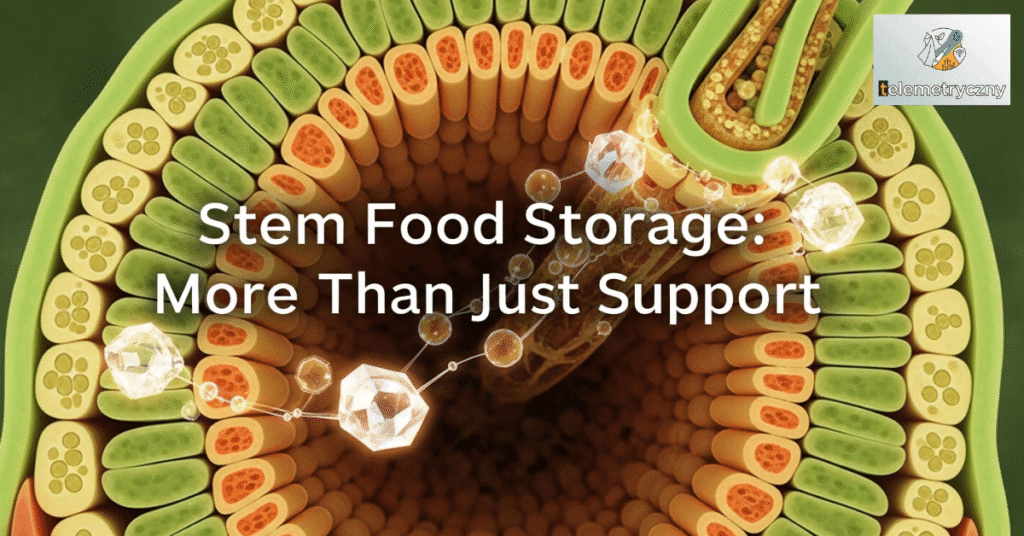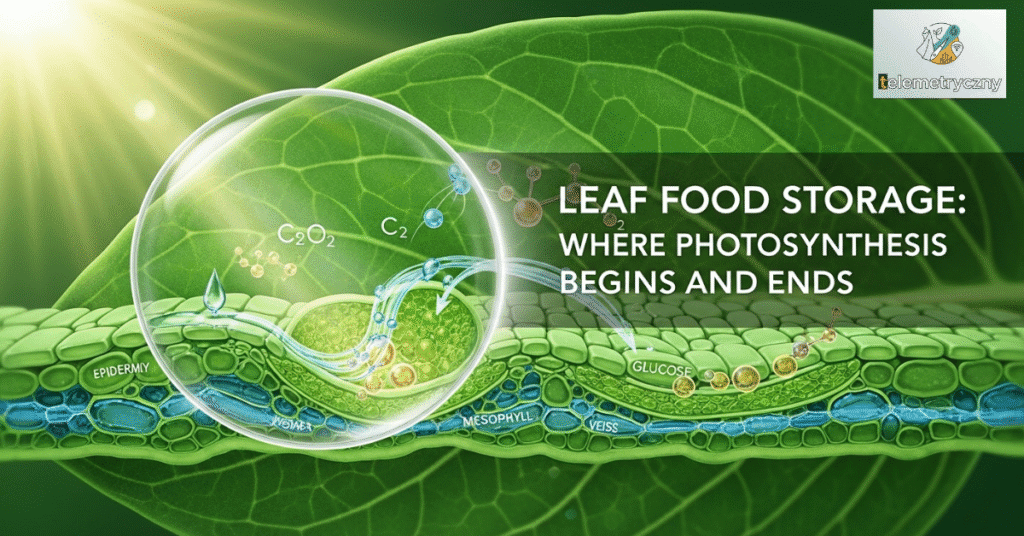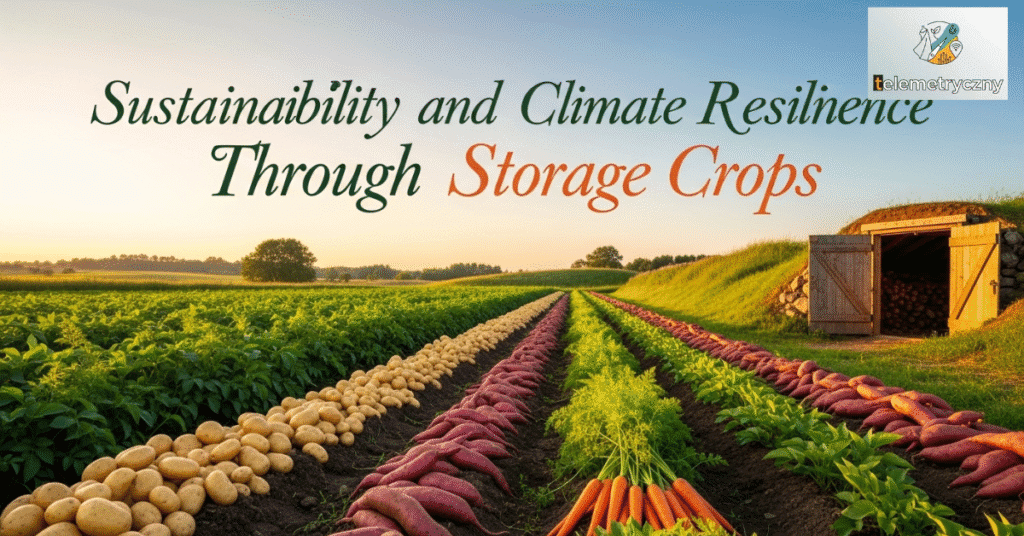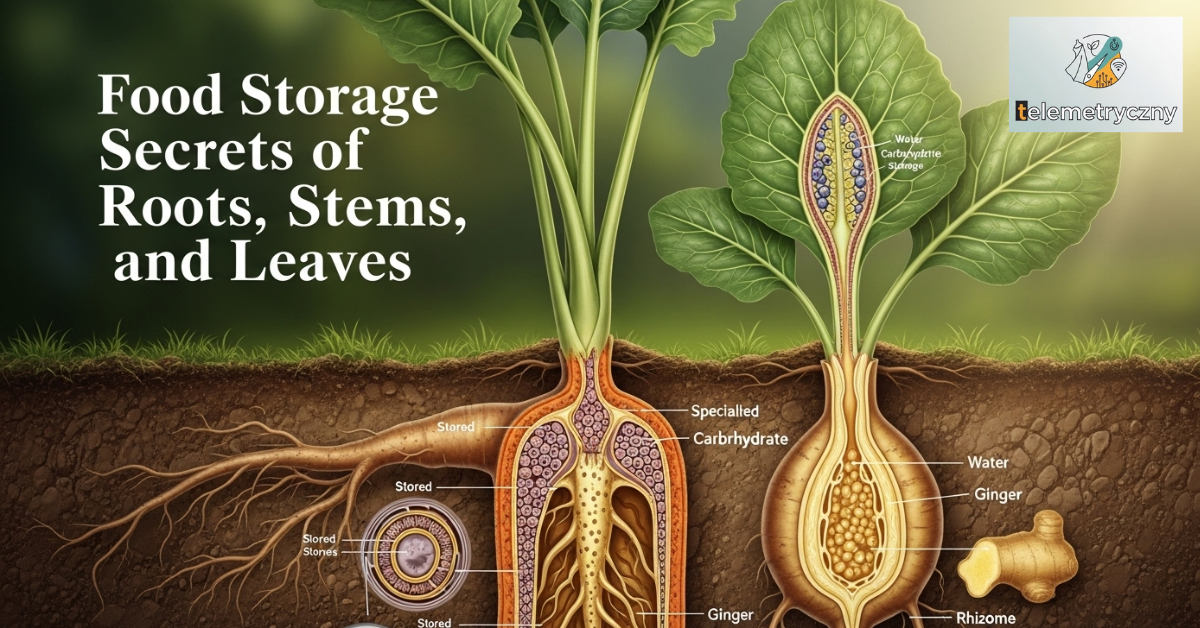You know that random moment when you’re cleaning out the kitchen and find a potato that’s sprouted little roots in the dark? It makes you pause and think how do plants manage to store food like that? I used to believe food storage was only something animals (or humans with fridges) did, but turns out, plants are quietly doing it too right under our noses, in roots, stems, and even leaves.
In this post, we’re diving into the surprisingly clever ways plants tuck away their food for later. Whether it’s nutrients stored in lush greens, moisture stored in a thick stem, or starch concealed deep within a root, you’ll receive a straightforward explanation of how it all functions. Consequently, this is the perfect answer to your question on how plants cope with adversity.
What Is Food Storage in Plants?
Photosynthesis, which turns sunlight, carbon dioxide, and water into glucose (sugar), is how plants, as opposed to animals, make their own sustenance.It is this glucose that drives the plant’s development.However, the problem is that plants don’t necessarily require that much energy at every moment. So what are they doing? It is kept in storage.
Plants use food storage to store excess glucose in the roots, stems, and leaves, where it is subsequently converted into proteins, lipids, sugar, and starch. When there are no longer any growing seasons or when unfavorable weather circumstances like drought or cold strike, this food will be helpful.
See More: What Animal Eats Rabbits
Why Do Plants Store Food?
1. Survival in Harsh Conditions
Plants can’t go anywhere when the weather turns bad. They just stay put. But they’ve got a way to deal with it they survive by using whatever energy they had saved up earlier. That’s it. No magic, just basic survival.
2. Support Growth and Reproduction
Fruits, seeds, blooms, and new shoots are all powered by stored food. When a seed sprouts, it depends only on its stored nutrients until it is able to carry out photosynthetic functions on its own.
3. Tissue Repair
The wind, animals, and insects can all damage plants. Tissue regeneration and repair are facilitated by their ability to retain nutrients.
4. Perennial Lifespan
There are certain plants that can live for years or even decades. They rely on food stores to continue development following dormancy during off-seasons when favorable conditions return.
Types of Food Stored in Plants
Starch
The most common storage form. Starch is produced by plants from glucose and is mostly stored in the roots and seeds. To power the plant, starch is converted back into glucose as necessary.
Sugars
Fruits and occasionally stems (such as sugarcane) are used for storage. Sugars offer rapid energy and are more soluble.
Fats and Oils
Some seeds like sunflower and nuts store energy in fat form more compact and high-energy.
Proteins
Stored mostly in seeds for supporting seedling growth.Legumes high in protein include beans and peas.protein-rich.
Root Food Storage: Nature’s Underground Pantry
Roots are like a plant’s secret treasure chest. Hidden underground, they quietly store large amounts of food. Here’s how it works:
Examples of Root Storage:
- Sugars and carotenoids: are stored in carrots.
- Rich in minerals: and sugar are beets.
- Water and carbs: are packed into radishes.
- Sweet potatoes: Store enormous amounts of starch
As storage organs, roots also absorb nutrients and water from the earth. The root of many plants expands as the sugars and carbs build up.
Why Roots?
Their underground home shields them from weather, fire, and predators. It’s a safe place to store vital resources.
Stem Food Storage: More Than Just Support

Stems usually support the plant above ground, but in some species, they also act as storage structures.
Examples of Stem Storage:
- Tubers: that store starch in underground stems are called potatoes.
- Ginger: An oil and sugar-storing rhizome.
- Sweet: nectar abounds on the tall, connected stem of sugarcane.
- Cacti: Their fleshy stems serve as stores for nutrients and water.
Stem Modifications That Store Food:
- Rhizomes: Ginger, turmeric, and other horizontal subterranean stems.
- Tubers: are enlarged stems that include buds or “eyes,” like potatoes.
- Take garlic: or onion for example what we call a bulb is just a short little stem hiding under thick, juicy leaves that store all the good stuff.
- Now corms: like taro or crocus? They’re basically fat, stubby stems that grow straight up and act like nature’s backup battery.
Stems are not just straws for water transport. In some plants, they become storage banks loaded with nutrients that sustain the plant during dormancy or help it regrow.
Leaf Food Storage: Where Photosynthesis Begins and Ends

Leaves are where plants make food but some also store it. While they generally don’t store large quantities, in certain species, leaves double up as both kitchens and pantries.
Examples of Leaf Storage:
- Onion: The bulb is made up of meaty leaves that store food.
- Aloe vera’s thic: fleshy leaves aren’t just for show they’re packed with water and healing stuff the plant saves for later.
- Lettuce and cabbage: Their leafy cells quietly store water and carbs, keeping them fresh and full of energy.
- Spinach: Has leaves rich in stored proteins and iron.
Leaves are exposed, so food stored here is less protected. But in some plants, thick or folded leaves help retain moisture and nutrients for tough times.
Seasonal Changes and Plant Food Storage Cycles
Plants adapt their storage strategy according to the seasons.
Spring & Summer
Photosynthesis is high, and food is produced in surplus. Plants store this in roots, stems, and leaves.
Autumn
The plant slows down. Food is moved from leaves (which may fall off) into roots and stems for safekeeping.
Winter
Plants typically go dormant. As with a hibernating bear, they survive on food that has been hoarded.
It is essential to comprehend this cycle in agriculture. Farmers often harvest when food storage is at its peak—like digging up potatoes or pulling carrots when they’re full of starch.
The Role of Plant Storage in Human Nutrition
Plants that store food are not just fascinating they’re lifesaving.
- Rice, wheat, corn, potatoes, and cassava are among the staple foods that feed people all across the world. Each one of these has a lot of sugar or starch stored.
- Essential sources of plant protein include legumes such as beans and lentils, as well as high-protein seeds.
- Fatty seeds, including sunflower seeds and peanuts, provide nutritive oils.
By knowing how plants store food, we can increase harvests, decrease hunger, and enhance human food storage practices.
How Farmers Use Food Storage Knowledge
Plant food storage isn’t just science it’s practical.
- Farmers plan their planting seasons based on when plants naturally store the most energy. It helps them get the best out of every crop.
- Selective breeding is all about improving storage parts—like making tubers bigger or seeds richer in protein. It’s a smart way to grow better food.
- To keep food available for longer, we rely on crops that won’t spoil easily during storage. That’s a huge part of planning for food security
Plant storage organs are actually the foundation of large agricultural industries. Consider growing potatoes, sugarcane fields, or cassava in tropical environments.
Sustainability and Climate Resilience Through Storage Crops

Climate change resistance is higher for crops that store food. Storage crops are stable throughout dry seasons or severe weather.
- Because it stores food underground, cassava grows well in poor soils.
- Millets and sorghum are tough survivors.By utilizing the energy stored in their grains, they continue to grow stronger even in the absence of rain.
- Cacti and succulents are adapted to the desert environment. Their dense leaves and stems retain water and nutrients, almost as if they were carrying a backup supply.
In poor countries in particular, these crops are essential to sustainable farming.
Scientific Research & Biotechnology Advancements
Plant scientists are constantly studying how to enhance food storage:
- Genetic modification helps increase starch or protein levels.
- CRISPR technology is being used to make crops more drought-resistant by improving storage.
- Research on chloroplast efficiency helps boost photosynthesis, leading to more food production.
This knowledge doesn’t just help plants it can revolutionize food storage for humans, reducing waste and improving shelf life.
How Understanding Plant Storage Helps Us
Why it matters:
- Because the food plants: store is the same stuff that keeps us going. Our bodies require it for energy, vitamins, and other beneficial things.
- Knowing when plants store their food allows farmers to maximize their yields by picking at the ideal time.
- Proper food storage: extends its shelf life. When supplies run low or delivery are delayed, that’s a significant concern. Nobody wants to go hungry.
- AIn addition plants: that store food are like unsung heroes since they endure when others do not due to the erratic climate.That helps us keep feeding people, no matter the weather.
If you eat food and we all do it’s worth knowing that roots, stems, and leaves don’t just grow randomly. They’re busy storing stuff for the plant to survive. Pretty cool, right?
See More: Am I Trans Quiz
Conclusion
Next time you’re chopping a potato or peeling an onion, just stop for a moment. Crazy how these simple things do so much more than just fill our plates, right ? In addition to growing haphazardly, plants are intelligent. In order to live, grow, and continue, they store nourishment in their roots, stems, and leaves.
Even more amazing is that this natural food storage is how we obtain our food, not just a result of plants doing what they are supposed to. It fills our plates, sustains farmers, and keeps agriculture going. Every veggie seems a bit more unique when you know how it all works.In fact, you might want to grow some in your own backyard.
FAQs
Why do plants store food in roots, stems, and leaves?
can endure harsh environments like winter or drought and to support development during periods of low sunlight.
What food is stored in roots?
Mostly starch. Examples include carrots, radishes, and sweet potatoes.
How do stems store food?
Stems like potatoes store starch, while others like cactus store water and nutrients.
What do leaves store?
Leaves store sugars, water, and nutrients like in spinach or lettuce.
Why is this important to humans?
We eat many plant parts that store food. This knowledge also helps in farming and food production.
Hi,
I’m Tehreem, a content writer specializing in SEO-optimized articles that rank and engage. Whether it’s AI-assisted or fully human-written content, I deliver clear, creative, and results-driven writing.


1 thought on “Food Storage Secrets of Roots, Stems, and Leaves”